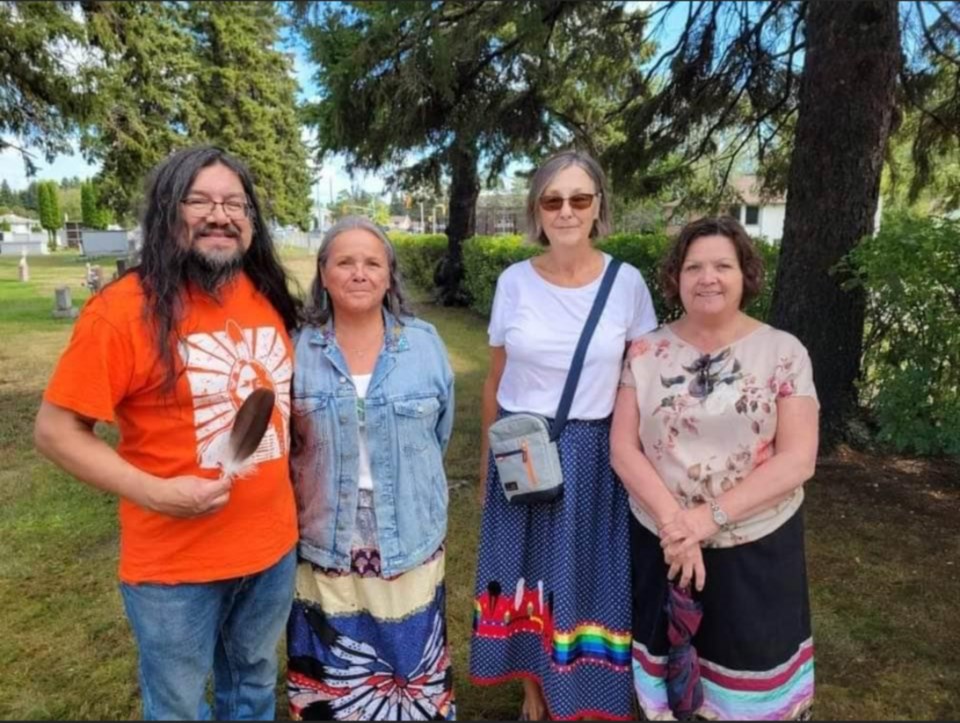For well over a century, no one knew what happened to Emma Lafford of Garden River First Nation.
She was uprooted from her grandparents’ home in Michipicoten by an Indian agent — along with her older sister, Fannie Nolan — and placed in St. Joseph’s Indian Residential School in Thunder Bay, Ont. in 1907.
Three years later, Lafford ended up in a Thunder Bay hospital.
She was never seen or heard from again.
But Carol Hermiston, an elder-in-residence at Algoma University and Nolan’s granddaughter, believes she has tracked down Lafford’s final resting place more than a century later: in a mass grave, along with the remains of other residential school students, at a cemetery in Thunder Bay.
“I don’t know how many people really know — Emma, as far as I know, is the only little girl from this area who didn’t make it back home. She was sent to Thunder Bay when she was seven years old, and she died up there when she was 10,” said Hermiston. “There’s been nothing said, nothing has happened, nothing to acknowledge it.
“It’s heartbreaking. It’s a very heartbreaking story.”
Disturbed by the discovery of potential unmarked burials at a former residential school site in Kamloops, B.C., Hermiston made the decision to search for her long-lost relative last summer during her walks along the shoreline of Batchawana Bay.
“Every day that I walked, I saw two eagles. It just struck me: I have to find Emma. I’ve got to find Emma,” she said.
Over the course of last summer, Hermiston would begin collecting records, obtained by herself and others, in order to piece Lafford’s story together.
Hermiston’s search would lead her to cross paths with award-winning Indigenous journalist and author Tanya Talaga, Anishinabek Nation deputy regional grand council chief Travis Boissoneau and David Thompson of Thunder Bay.
Thompson was looking for his own family members who attended Shingwauk Indian Residential School when he came across information about Lafford. He then reached out to Boissoneau, who is from Garden River First Nation.
Boissoneau was a good friend of Talaga, who had family members that attended the residential school in Thunder Bay.
“They decided they were going to look for the family of Emma,” Hermiston said.
Hermiston contacted Talaga around that same time through social media.
“She messaged me back very, very quickly and I told her I was trying to find my grandmother’s sister who had died up at that school,” Hermiston recalled. “She said she would help me, but at the moment she was helping the family of another little girl who had passed from Garden River.”
Hermiston informed Talaga that she was looking for Lafford.
“She had typed back, ‘OMG.’ She called me and she said, ‘give me your phone number,’ and within 10 minutes she had called me,” said Hermiston. “She said ‘that’s the little girl whose family we’re looking for.’”
It turned out that Thompson had obtained some records which subsequently helped piece Lafford’s story together, including documents showing that an Indian agent asked Indian Affairs what should be done with Lafford’s body after her death.
“He had found other documentation, pictures and things, and he sent them to me,” Hermiston said.
Records indicate that Lafford was admitted to St. Joseph’s Hospital November 14, 1910, where she would stay for a period of two weeks before her death. Although a doctor at the hospital attributed her death to typhoid fever, Hermiston would learn that Lafford’s appendix burst.
Those records also show that an Indian agent — a government official tasked with carrying out federal policy with regards to Indigneous Peoples — contacted Indian Affairs and informed the federal agency that Lafford had died, and asked about next steps because there was no money to bury her.
Through her own extensive legwork and the help of others, Hermiston would eventually discover Lafford’s final resting place: a mass grave containing the remains of residential school students located inside St. Andrew’s Cemetery in Thunder Bay.
“They’re buried in this big graveyard, but it’s a mass grave. They don’t know who’s there, they just know that’s where the children are,” she said.
In August 2021, Hermiston met up with Thompson and Boissoneau in Thunder Bay and held a ceremony at the cemetery. Hermiston took some earth from Garden River to place at the memorial.
“I don’t believe it just happened — I actually believe that the spirit of my grandmother and Emma were leading me there,” Hermiston said of the discovery.
Another ceremony to honour Lafford was held in Garden River in September 2021. Garden River First Nation Chief Andy Rickard attended the ceremony.
“It goes to show that this is one of many stories — not just within Garden River, but many other communities — that brings that to the attention of mainstream society, because they need to understand the impacts even to this day,” said Rickard. “I know it’s still traumatic for the family. There was still that missing piece within the family that didn’t have their closure.”
Rickard says that Garden River has initiated its own process for acknowledgment and healing in light of the potential discovery of unmarked graves in Kamloops.
“It really kind of reminds us that these are some of the stories that are going to come out of some of those difficult and challenging conversations that we’ll be having,” he said.
While Lafford’s remains have yet to be physically repatriated, Hermiston believes that she’s now resting beside Nolan at the cemetery in Garden River.
Hermiston says that for years, her grandmother would travel to Thunder Bay to find her sister. Now she feels that the sisters have been reunited.
“For all intents and purposes, Emma’s spirit has been brought back home,” she said.
A national residential school crisis line has been established to provide support to former students and their families. The 24-hour crisis line can be accessed at 1-866-925-4419.
